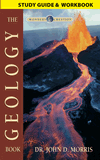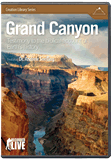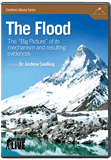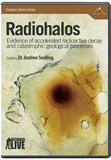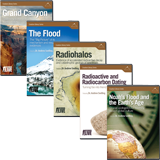Gold
A Little Bit of Heaven on Earth
No other mineral has provoked so much wonder and strife. Of all earth’s commodities, gold was chosen from among earth’s minerals to represent God’s own glory. Its unique qualities and current location on the earth are no accident, influencing the history of nations.
Gold has fascinated people since the earliest times. It has always been valued because of its warm color, glistening beauty, durability, and ease of shaping into exquisite jewelry. Nations have acquired and treasured it, traded and warred over it. Due to its rarity, gold’s principal function has been as currency and as the preferred way to store wealth.
Created for Eternity
God gave gold many properties that make it so valuable. It does not rust or tarnish. Fire does not destroy gold but only makes it purer. It can be alloyed to other metals, like copper, to add strength without losing beauty. Gold is easy to shape. Under the right conditions, 1 ounce (28 g)1 can be stretched into a wire 60 miles (100 km) long, or hammered into a big sheet, 100 feet by 100 feet (30 m x 30 m), to cover the dome of a fancy building.
Another amazing quality of gold is that it essentially lasts forever. In fact, we can safely conclude that most of the gold mined since the flood is still readily available (in active use or hoarded). The total amount has not changed; it has just been recycled into jewelry, tooth fillings, computer components, and lots more.
This means that we can estimate the total amount of gold that has ever been mined: about 180,779 tons (164,000 m. tons).2 If gathered into one location, this treasure hoard would fill a seven story office building, 67 feet (20 m) high and 67 by 67 feet at the base (417 m2).
Because of its special properties, gold plays a prominent role throughout Scripture. It is mentioned over 450 times, more than any other metal. It often symbolizes God’s own regality, preciousness, immortality, holiness, and glory.
Genesis specifically mentions that high-quality gold was available to Adam’s descendants in the land of Havilah (Genesis 2:10–12), and the book of Revelation closes with a beautiful description of the holy New Jerusalem, which will descend from heaven with a street of pure gold “like transparent glass” (Revelation 21:10, 21).
When Did Gold Deposits Form?
In the beginning, God created enough gold to meet all our needs, and he distributed the gold in just the right places to accomplish his ultimate purposes for humanity. Since no new gold is being formed, God had to make sure that the original gold would be accessible after the flood had ripped apart and reshaped the continents. How did he do this?
Primary and Secondary Deposits as a Result of the Flood
During the flood, catastrophic plate tectonics reshaped and rebuilt the earth’s crust into multiple new continents with new mountains.3 At this time, gold returned to rocks near the earth’s surface. Though the details differ, the processes had a few things in common. Initially hot acid waters4 in deep crustal rocks dissolved the gold, and molten magma and volcanic waters carried it toward the surface (Figure 1). This hot material then entered into cracks in the rocks near the earth’s surface.

Common Types of Gold Deposits
Primary gold deposits occur where hot acid waters dissolved metals deep in the earth and then rose toward the surface, carrying the metals with them.
Secondary gold deposits occur where rain and other natural forces eroded primary deposits and then washed the gold to other places (called placer deposits).
Some primary deposits are associated with volcanic activity during the flood. As the earth’s plates collided, the plates melted, sending hot magma and hot water toward the surface. This hot water was rich in gold, copper, and other metals.
Other gold deposits are found in pre-flood rocks. These deposits were formed during creation week, when God raised the land out of the ocean on day three. During the flood, some of these deposits were changed under great heat and pressure and then pushed to the surface.
As it cooled, the gold remained in place, either associated with certain large granite bodies (often with copper) or in veins and ore bodies.5
After these “primary gold deposits” were put in place, heavy rains and other natural forces eroded many of the rocks. Because gold is very heavy and resistant to corrosion, it settled out into what are called “placer deposits.” These secondary gold deposits include the gold particles found at Sutter’s Mill, which sparked the California gold rush in 1849.
Most placer deposits formed at the end of the flood when the retreating waters drastically eroded the landscape. Indeed, most of the flood-generated primary and secondary deposits formed during the closing stages of the flood, especially during the building of the Rockies, Andes, Himalayas, European Alps, and other related mountain ranges.
Primary and Secondary Deposits During Creation Week
That explains flood-related gold deposits, but we also find gold in pre-flood sedimentary layers.6 What biblical event could possibly explain these gold-filled sediments before the flood washed over the earth?
The answer: the creation week.
To properly understand this oft-overlooked period of biblical history, let’s look more closely at perhaps the world’s most famous gold deposit—the Witwatersrand.
Until recently, the Witwatersrand sedimentary basin of South Africa accounted for about 40% of all known gold (and 45% of total gold production). Like a great sea reef rising gently above the surrounding landscape, the Witwatersrand is a ridge running some 60 miles (100 km) in a broad arc across South Africa’s interior. Among locals, it is known simply as “the reef” (or “rand” in Afrikaans).
This is a massive placer deposit, similar to the ones described above but on a much bigger scale. Placers get their name because water transported the gold particles into their new place, mingled with silt and sometimes, as in this case, with pebbles too. But how did such a large “reef” appear? Secular geologists argue that the “Golden Arc” was once the edge of a huge inland lake, where gold-laden sediments settled for millions of years.
But the Bible offers a much different answer—God’s separation of land and water on day three (Genesis 1:9–10). This was a dramatic event in earth history, as God built the pre-flood supercontinent. It seems that all land was initially buried under the original globe-covering waters. Then as God raised the supercontinent above the ocean surface on day three, water rushed off the land and caused massive erosion, decimating many of the earlier primary gold deposits, concentrating it into placer deposits.
Around 1,700 years later, the global flood laid down new fossil-bearing layers atop these creation week deposits, and the mountain-building processes at the end of the flood pushed some of these lower layers to the surface.
So we have now seen the main periods of history when gold was deposited. A total of 65% of known, mineable gold deposits are in rocks associated with creation week.7 Less than 2% of known gold deposits were produced in the “post-creation, pre-flood” rocks. About 33% of the remaining known gold deposits lie in flood-related rocks.
Still Being Deposited Today
We see some of these processes at work today but at a much smaller scale. The creation and the flood were one-time events that produced unique conditions that would never be repeated, vastly increasing the speed and scale of new deposits.
Some might claim that gold in granites and related vein deposits and ore bodies requires more time to form than was available during the year-long global flood catastrophe. However, accumulated evidences now indicate granites formed and cooled rapidly. Metal-laden hot waters would have been expelled from the granites during a crucial, final stage in the process of their formation, quickly producing deposits of gold and other precious metals.8
Furthermore, we can see gold being deposited rapidly today. At the giant, volcanically produced Ladolam gold deposit at Lihir in Papua New Guinea, volcanic waters are still depositing gold at a rate of 52 pounds (24 kg) per year.9 At this rate, this giant gold deposit (containing 3 million pounds [1.3 million kg] of gold) would have formed in about 55,000 years. “Ancient” ore fluids had 100-1,000 times more gold in them,10 and the flood upheaval would have released such volcanic fluids at much faster rates.
All the gold that God originally created is still available today, just in different types of deposits. Ever since Adam’s descendants explored the land of Havilah, man has mined and treasured gold. In the past, it has usually been the metal of kings, palaces, priests, and temples, including Israel’s tabernacle and Solomon’s temple. And yet God has destined that the poor and oppressed who become his children through repentance and faith will enjoy pure gold in his heavenly city forever. There we will all be priests and kings, serving and worshipping our Creator in unimaginable glory (Revelation 1:6).
Nuggets of Knowledge . . .
- One cubic foot of gold weighs more than half a ton.
- The ocean waters contain an estimated 10 billion tons of gold (along with most other elements). That’s over 1 ton per person.
- Pure gold does not easily corrode, it does a good job conducting electricity and heat, and it has a high melting point at 1,948°F (1064°C). So it has many applications in medicine, engineering, aerospace, and the chemical industry.
- The largest gold nugget ever found was about 25 inches (60 cm) long and 10 inches (31 cm) wide, weighing in at approximately 160 pounds (72 kg). Two Australian men found “the Welcome Stranger” in 1869 under a tree, 2 inches underground. In modern U.S. dollars, it would be worth well over $3.5 million.
- The largest stockpile of gold today is held at the Federal Reserve Bank of New York. The underground vault holds around 550,000 gold bars total, worth $485 billion U.S. as of November 2010. (Around 95% of the gold in the Federal Reserve Bank is owned by non-USA governments.) The vault was built on solid bedrock, which was necessary to support the gold’s weight of 5,000 metric tons.
Answers Magazine
January – March 2011
This issue of Answers points a telescope at the heavens. Explore evidences that the universe is young, from blue stars to spiral galaxies. Get up-to-date on the search for extraterrestrial life, and be the first to read Dr. Jason Lisle’s new model explaining distant starlight. You also don’t want to miss articles on living fossils and other wonders of our own planet that point to a recent creation and global Flood.
Browse Issue SubscribeFootnotes
- Gold is measured in Troy ounces (31 g), but to keep consistent with the other commonly known weights mentioned in the article, I used the 28 g number most people are familiar with here.
- As of 2008 in R. M. Butt and R. M. Hough, “Why Gold Is Valuable,” Elements 5.5 (2009): 277–280.
- A. A. Snelling, “Can Catastrophic Plate Tectonics Explain Flood Geology?” in The New Answers Book 1, ed. K. Ham (Green Forest, Arkansas: Master Books, 2006), pp. 186–197.
- A. E. Williams-Jones, R. J. Bowell, and A. A. Migdisov, “Gold in Solution,” Elements 5.5 (2009): 281–287.
- R. M. Tosdal, J. H. Dilles, and D. R. Cooke, “From Source to Sinks in Auriferous Magmatic-Hydrothermal Porphyry and Epithermal Deposits,” Elements 5.5 (2009): 289–295.
- Within the biblical framework of earth history, nearly all Precambrian rocks were in place before the Flood. See A. A. Snelling, Earth’s Chide=true atastrophic Past: Geology, Creation and the Flood (Dallas, Texas: Institute for Creation Research, 2009).
- More than 72% of the Creation Week gold deposits are in secondary placer deposits, the rest being in primary vein and lode deposits associated with God’s continent-building processes. H. E. Frimmel, “Earth’s Continental Crustal Gold Endowment,” Earth and Planetary Science Letters 267 (2008): 45–55.
- A. A. Snelling, “Catastrophic Granite Formation: Rapid Melting of Source Rocks, and Rapid Magma Intrusion and Cooling,” Answers Research Journal 1 (2008): 11–25.
- S. F. Simmons and K. L. Brown, “Gold in Magmatic Hydrothermal Solutions and the Rapid Formation of a Giant Ore Deposit,” Science 314 (2006): 288–291.
- C. H. Heinrich, “How Fast Does Gold Trickle out of Volcanoes?” Science 314 (2006): 263–264.
Recommended Resources

Answers in Genesis is an apologetics ministry, dedicated to helping Christians defend their faith and proclaim the good news of Jesus Christ.
- Customer Service 800.778.3390
- © 2025 Answers in Genesis




